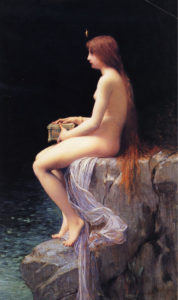The story of Pandora, as it is commonly known, tells of a naive young bride who was gifted a box by Zeus following her marriage to Epimetheus but was told that she could never open it. After her curiosity got the better of her, she opened the box and unleashed all of the evils of the world forevermore. Before closing the box she noticed that something remained at the bottom, Hope, whom she released to heal the wounds in mankind that the evils had touched. This is why it is important to remember that Hope exists even at the bleakest of times. While this is a touching tale, the original Greek myth is far more sinister.
The earliest form of the myth of Pandora¬†that we know of comes from Hesiod, who mentions her in both of his texts, briefly in¬†Theogony¬†and expands in more detail in¬†Works and Days, with both dating to between the 8th and 7th centuries BCE.¬†In Theogony,¬†Hesiod writes that Pandora¬†was the first human woman created, and was made by Hephaestus from the earth at the order of Zeus to “make an evil thing for men as the price of fire”, in order to punish all of the Golden Race of mankind, as fire was stolen from Olympus by Prometheus (Epimetheus’s brother).¬†Theogony¬†briefly outlines this unnamed female’s creation; she¬†was described as a “beautiful evil” and who gave way to “the deadly race and tribe of women who live amongst mortal men to their great trouble”.
While remaining unnamed, this female character in Theogony bears a remarkable resemblance to the Pandora that is outlined in Hesiod’s¬†Works and Days.¬†In this, Zeus orders Hephaestus to “mix earth with water and to put in it the voice and strength of human kind, and fashion a sweet, lovely maiden-shape, like to the immortal goddesses in face.” Other Olympian deities are then called on to give gifts to make her¬†irresistible¬†to Epimetheus, such as “Athena to teach her needlework and the weaving of the varied web; and golden Aphrodite to shed grace upon her head…Hermes the guide, the Slayer of Argus to put in her a shameless mind and a deceitful nature.” This creation was named Pandora, meaning ‘the all-endowed’ as she had received a gift from each deity. Once created she was sent to Epimetheus as a gift, something Prometheus had warned his brother about, fearing retribution for his theft of fire, however she was accepted onto the Earth. There, she opened her jar (this was changed to a box through the mis-translation of ancient texts in the 16th century) and released the “ills and hard toil and heavy sicknesses” into the world, bringing the Golden Race of men to an end. Much like the later version of the myth, Hope remained in the jar; however, she was never released as Pandora closed the lid again, imprisoning her inside upon the orders of Zeus. Following Pandora, the Greek myths continue with the Silver Race of men which sees the first introduction of women and with a continuous cycle of birth and death, rather than the immortality that the Golden Race had been granted.
The myth of Pandora continues to be referenced throughout popular culture, for example with the 2003 film¬†Lara Croft Tomb Raider: The Cradle of Life¬†which follows the journey of Lara attempting to keep Pandora’s box of evils closed. Pandora is also mentioned in the 2009 James Cameron film¬†Avatar¬†as the planet where humans are threatening the existence of the Na’vi tribe, much like Pandora originally threatening mankind in Greek mythology.
Overall the sinister Greek myth of the creation of Pandora and its subsequent popular culture references to her character make her a very interesting female subject in Greek mythology.
If you’re interested in reading more about Hesiod’s Pandora, check out H.G. Evelyn-White’s translations of Hesiod (and Homer) in¬†Hesiod, the Homeric Hymns and Homerica.
-Devon Allen
Junior Girl
Girl Museum Inc.


Absolutely brilliant! I had no idea Pandora came from such a dark place.